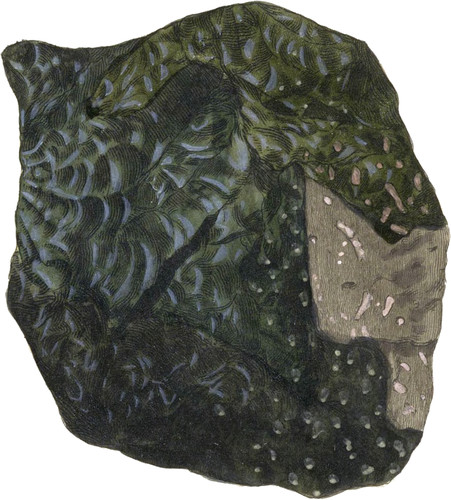 Enlarge
Enlarge
British Mineralogy
Glassy Pitchstone
- Class 2. Earths.
- Order 1. Homogeneous.
- Gen. 4. Silex.
- Spec. 7. Pitchstone.
- Syn.
- Pitchstone. Kirw. 1. 292.
- Pechstein. Emmerl. 1. 262.
- Petrosilex résinite. Haüy, 4. 386.
These Stones are so like Pitch in general, that no one could mistake them, except when they vary in colour and have a glassy appearance, as is sometimes the case. The fracture in some fine specimens is large, concentric, sharp, and conchoidal, in others more splintery. We figure one of the latter, which includes Petuntse, or Feldspar, and also has more or less of a glassy appearance. This, taken in the whole, would be called Pitchstone Porphyry. It came from Arran in Scotland, and contains Alkali. Hence it nearly approaches common glass.
Quartz is so extremely likely to vary in its appearance, especially when chemically combined with colorific or other matter, that it may be considered as liable to as many varieties as any other known substance. Thus it varies from Calcedony or Agate, to Cachalong and the various Opals:—see tab. 111. and also to Jasper, wax-like Hornstone, Flint, and even Pitchstone. Under the term Pitchstone may be included those siliceous stones which are fusible and resemble glass, as they can scarcely be separated but by fancied differences (as the usual appearance of Pitch may be called either glassy or pitchy). There are, however, distinctions in some of them, which may be founded on geological principles, as their being chiefly combined with either Lime, Magnesia, or Alumine and Alkali, which often, perhaps, depends upon the kind of rock they are formed in: the colouring matter being either Bitumen, Manganese, or Iron, in different states of oxygenization and quantity.
Pitch is of different textures, and has a fracture more or less large or small, conchoidal, or glassy, and lighter or darker in the splintery illinitions, depending on the degree of heat to which it has been subjected. Pitchstone varies as much; therefore, the present specimen may be called a Pitchstone having a glassy appearance, with a rather small conchoidal and sharp splintery fracture. As it includes Feldspar, which spots it in some parts, it may be called Pitchstone Porphyry. It is generally harder than glass, or will scratch glass as Flint does. We are not sure that even Bitumen enough may not be found hereafter, to mark its analogy with Pitch very completely.
The present specimens were obtained from Arran, where the substance seems to be found in veins in a Porphyry rock, and to pass into the more usual appearance of Pitch. It has occasionally a basaltic aspect.
The visible and chemical characters of Obsidian agree so closely with those of Pitchstone, that they must surely be considered as the same species.

